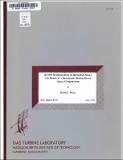| dc.contributor.author | Weigl, Harald Jürgen | en_US |
| dc.contributor.other | Massachusetts Institute of Technology. Gas Turbine Laboratory | en_US |
| dc.date.accessioned | 2016-10-06T21:22:30Z | |
| dc.date.available | 2016-10-06T21:22:30Z | |
| dc.date.issued | 1997 | en_US |
| dc.identifier.uri | http://hdl.handle.net/1721.1/104760 | |
| dc.description | July 1997 | en_US |
| dc.description | Includes bibliographical references (pages 297-302) | en_US |
| dc.description.abstract | Rotating stall and surge have been stabilized in a transonic single-stage axial compressor using active feedback control. The control strategy is to sense upstream wall static pressure patterns and feed back the measured signal to an annular array of twelve separately modulated air injectors upstream of the rotor. At tip relative Mach numbers of 1.0 and 1.5, the control achieves a 11% and 3.5% reduction in stalling mass flow respectively. With control, the steady amount of injected air is equal to 3.6% of the design compressor mass flow. At a tip Mach number of 1.0 the stall inception dynamics and effective active control schemes are similar to results for low-speed axial compressors. The range extension can be achieved by individually damping the first and second spatial harmonics of the pre-stall rotating stall perturbations using constant gain feedback. The pre-stall dynamics are different at a tip Mach number of 1.5 than at the lower speed. | en_US |
| dc.description.abstract | Both one-dimensional (surge) and two-dimensional (rotating stall) perturbations must be stabilized to increase the compressor operating range. At design speed, the instability is initiated by approximately 10 rotor revolutions of rotating stall followed by classic surge cycles. In accord with the results from a compressible stall inception analysis which has been applied to the compressor with actuation and refined based on forced response measurements, the zeroth, first, and second pre-stall harmonics each include more than one lightly damped mode which can grow into the large amplitude instability. Forced response testing has identified several modes traveling up to 150% of rotor speed for the first three spatial harmonics. Simple constant gain control cannot damp all of these modes and thus cannot stabilize the compressor at this speed. | en_US |
| dc.description.abstract | Robust dynamic control is therefore used to stabilize the multiple modes which comprise the first three harmonic perturbations in this transonic region of operation. Eigenvalue perturbations are incorporated into an H [infinity] control design to directly address uncertainty in the dominant eigenvalue stability. | en_US |
| dc.description.sponsorship | Supported by NASA Lewis Research Center | en_US |
| dc.format.extent | 302 pages | en_US |
| dc.publisher | Cambridge, Mass. : Gas Turbine Laboratory, Massachusetts Institute of Technology, 1997 | en_US |
| dc.relation.ispartofseries | GTL report #226 | en_US |
| dc.subject.lcc | TJ778.M41 G24 no.226 | en_US |
| dc.subject.lcsh | Compressors | en_US |
| dc.subject.lcsh | Feedback control systems | en_US |
| dc.title | Active stabilization of rotating stall and surge in a transonic single stage axial compressor | en_US |
| dc.type | Technical Report | en_US |
| dc.identifier.oclc | 38078807 | en_US |
